Some of the most difficult NFHS rules and mechanics for newer officials to master are the three counts involved in advancing the ball: the four-second goalie count (Rule 4-19 and 20 Art. 5, the 20-second clearing count (Rules 4-14) and the 10-second count (Rule 4-15).
While the basic requirements and mechanics for each are fairly straightforward, the challenge emerges when an official is tasked in game situations with BOTH recognizing and communicating when each count begins and ends. It is IMPERATIVE that you understand and master this mechanic!
Understanding Possession
All counts begin with a player being in possession of the ball. Player possession is defined as the ability of a player “to cradle, carry, pass or shoot the ball” (Rule 4-5 Art 2.) Before initiating ANY count, be absolutely POSITIVE that the player is actually in possession. Often the level of play will influence what you determine to be possession. At the youth level, players should actively demonstrate one of the four actions. At higher levels of play, a bit more leeway can be given. It is better to wait than to start or end a count when a team does not actually have possession.
The Lead and Clearing Counts
Once a player gains possession in their defensive end, the Lead becomes the new Trail and is responsible for BOTH the the 20-second clearing and the four-second goalie counts.
20-Second Count
In order to perform the 20-second count it is ESSENTIAL that you have a working 20-second timer. UNDER NO CIRCUMSTANCES is any official to visually count to 20 or look at his watch. Taking your eyes off the players in transition is NOT an option and keeping both the 4 and a 20 count that is already in the works while running is almost impossible.
Be sure to check to see if your timer works before you go out on the field. Its a good idea to carry a small screwdriver and extra batteries with you in your bag. If you do not have a working timer, let you partner know IMMEDIATELY so that you can come up with a way to address the situation. Often times, veteran officials will have an extra timer. Information about purchasing a timer can be found on the Uniforms & Equipment page for information on where to purchase online or locally.
As soon as possession is gained, the new Trail pumps his hand and switches on his timer. This is NOT a verbal count and it is NOT a visual count.
As Rule 4-14 states, the timer continues to run until:
- the opposing teams gains possession.
- a player in possession steps ON OR OVER the midfield line.
- a loose ball breaks the plane of the midfield line.
- the official sounds his whistle for any reason.
If one of these hasn’t happened, the 20 count continues. The clearing team can carry, pass or kick the ball ON or OVER the midfield line. The ball can be in player possession or loose. If a count has been initiated against a clearing team and they loose the ball, the count continues! The ONLY things that will end the count are: the ball crosses the midfield line, a change in possession or a whistle. Turn the timer on and if the buzzer goes off the ball in player possession has not crossed midfield, whistle the play dead and award the ball to the opposing team.
Failure to Advance
The Trail will, most likely, be well behind the play and not in position to to determine whether of not the midfield line has been crossed . The Lead MUST signal to the Trail by raising his arm. If the play has gone on for a while, the Lead can also verbalize “He’s over!” to be sure the Trail ends the count before his timer buzzes.
If a team fails to satisfy these requirements within 20-seconds, they have committed a technical foul, failure to advance, and you have two options: whistle the play dead or treat it as a play on situation.
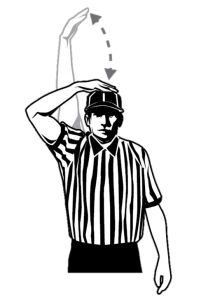 If the team clearing the ball is in possession and fails to clear the ball in 20-seconds, whistle the play dead, signal failure to advance and award the ball to the opposing team. Quick restart.
If the team clearing the ball is in possession and fails to clear the ball in 20-seconds, whistle the play dead, signal failure to advance and award the ball to the opposing team. Quick restart.- If the ball is loose, you can treat it as a play on. If the opposing team is about to gain possession of the ball, you can raise your hand to signal and verbalize “Play On.”
- If the opposing team gains possession, the Play On is over, if not whistle the play dead, award the ball to the opposing team and initiate a quick restart.
If the ball crosses midfield in time, simply switch your timer off.
Goalie Count
If the goalie gains possession IN THE CREASE, he is allowed four seconds before the ball must leave the crease. The goalie is considered in the crease as long as ANY part of his body is touching the crease (Rule 4-20 Art. 5). The goalie will gain possession in one of three ways: saving a shot, intercepting or receiving a pass or picking up a loose ball. The four-second count always happen in conjunction with a 20-second count.
- If the goalie is the first defensive player to gain possession, the four second count begins simultaneously with the 20-second count.
- If the defense has already gained possession and a 20-second count has been started, the four second count is concurrent.
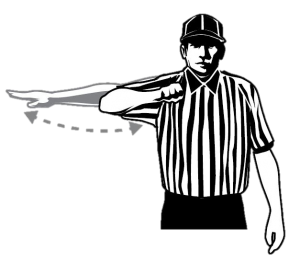 The four second count is a VISUAL count the new Trail official begins once the goalie gains possession of the ball in the crease. Do NOT count out loud. Each swing of the arm should equal one second. Practice your mechanic by saying to yourself “One Mississippi with each swing. Many newer officials get excited and count much to quickly. It is a good idea to practice in the mirror with a clock (you can use your phone) or go old school and count one Mississippi, two Mississippi etc… The goalie gets four seconds, so be sure to give him four seconds.
The four second count is a VISUAL count the new Trail official begins once the goalie gains possession of the ball in the crease. Do NOT count out loud. Each swing of the arm should equal one second. Practice your mechanic by saying to yourself “One Mississippi with each swing. Many newer officials get excited and count much to quickly. It is a good idea to practice in the mirror with a clock (you can use your phone) or go old school and count one Mississippi, two Mississippi etc… The goalie gets four seconds, so be sure to give him four seconds.
If the goalie in possession has not left the crease (i.e. no part of his body in contact with the crease) or the ball is loos and is still inside the crease when you END your count, that is you have completed the fourth swing of the arm, blow the whistle and signal a crease violation (same as the over and back signal in basketball). Award the ball to the opposing team in the alley.
If there is no violation, simply stop counting and drop your arm to your side.
Flip, Pump, Twirl and Chop
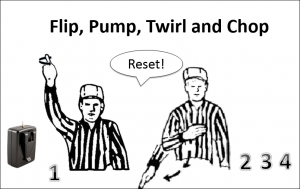 )If the Goalie is the first defensive player to gain possession in his defensive end you must initiate a 20-second count AND a four-second count AT THE SAME TIME. The mechanic in this situation is what I call flip, pump, twirl and chop. The Trail should flip his timer on and then reach his hand in the air to give the and twirl his hand to indicate a change of possession has occurred. You will often hear officials, especially in three-man mechanics, yell “Reset! Lower you hand as you would when giving the “Timer on!” signal (i.e The Pump). This flip/pump move is your one count for the goalie. Lower your hand and give a chop for the second, third and fourth of the goalie’s 4 count.
)If the Goalie is the first defensive player to gain possession in his defensive end you must initiate a 20-second count AND a four-second count AT THE SAME TIME. The mechanic in this situation is what I call flip, pump, twirl and chop. The Trail should flip his timer on and then reach his hand in the air to give the and twirl his hand to indicate a change of possession has occurred. You will often hear officials, especially in three-man mechanics, yell “Reset! Lower you hand as you would when giving the “Timer on!” signal (i.e The Pump). This flip/pump move is your one count for the goalie. Lower your hand and give a chop for the second, third and fourth of the goalie’s 4 count.
Resetting 20-Second and Goalie Counts
A whistle by the official will stop play and will either end or reset the 20-second count. This can be for the ball going out of bounds, whistle ending a Play On for a loose ball technical, to administer a time serving foul, a time out or an inadvertent whistle.
- If the riding team caused the ball to go out of bounds, award the ball to the clearing team, and when play restarts, initiate a new 20-second count.
- If there is a stoppage of play to administer a loose ball play on, play begins at the spot of the foul (or laterally in the alley if in the attack box) and when play resumes a new 20-second count is initiated.
- A time serving foul will result in a free clear, so there is no need for a 20-second count.
- If the ball is awarded to the Riding team in their offensive end (a change of possession), they will begin play with ten seconds to gain the attack area (see below).
“Get a Touch!”
Once the clearing team has initially gained possession of the ball on their offensive side of the midfield line they have 10 seconds to gain the attack area (Rule 4-15). A player in possession must make contact with the line or the ground inside the attack area to satisfy this requirement or a loose ball makes contact with the line, area or any grounded player. Most often a player steps on the line, usually the corner of the box. This is what coaches and players mean when they yell “get a touch!”
The two most common situations when a team is required to get the ball into the attack area within ten seconds are: after they have crossed the midfield line on a clear and when a change of possession occurs in their opponents defense end. The mechanics is very similar to the four-second count. However, the official most often responsible for the count is the Lead.
10 Second Count
 The count is a VISUAL count that begins once a team gains possession on their offensive side of the ball after a clear or following a change of possession in on their offensive end. Do NOT count out loud. Each swing of the arm should equal one second. You don’t want to look like Bruce Lee out there, so practice your mechanic by saying to yourself “One Mississippi with each smooth and controlled swing of the arm.you can also practice with a stop watch or a metronome to be sure you are doing it correctly!
The count is a VISUAL count that begins once a team gains possession on their offensive side of the ball after a clear or following a change of possession in on their offensive end. Do NOT count out loud. Each swing of the arm should equal one second. You don’t want to look like Bruce Lee out there, so practice your mechanic by saying to yourself “One Mississippi with each smooth and controlled swing of the arm.you can also practice with a stop watch or a metronome to be sure you are doing it correctly!
“He’s In!”
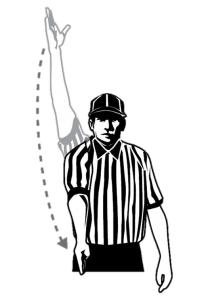 Once the requirements of gaining the attack area are met, the official should signal by raising his arm and then pointing to the box. This is especially important if you are not conducting the count. Often times the Lead may not have a good view of the play if it occurs on the far side of the field. As the Lead, positioned on Goal Line extended (GLE), he may be screened by players, the goal, the field may be crowned, or the lines may be difficult to make out. As the Trail comes up the field on a clear, he needs to determine if a count is in progress and assist his partner.
Once the requirements of gaining the attack area are met, the official should signal by raising his arm and then pointing to the box. This is especially important if you are not conducting the count. Often times the Lead may not have a good view of the play if it occurs on the far side of the field. As the Lead, positioned on Goal Line extended (GLE), he may be screened by players, the goal, the field may be crowned, or the lines may be difficult to make out. As the Trail comes up the field on a clear, he needs to determine if a count is in progress and assist his partner.
As the Trail will most likely be out of the Leads field a vision, it is good practice to also verbalize to your partner that a player in possession or a loose ball have touched inside the attack area by yelling “He’s in!” to be sure your partner ends the count.
Both officials should mimic this signal. It lets the coaches and players know that the count has been satisfied and it lets the officials know that over and back is now in effect.
Once the offense touches the ball into the box, may then use their entire half of the field without a new 10 count, unless they are stalling or intentionally cause the ball to cross midfield. (Rule 4-15 Art. 1)
Over and Back
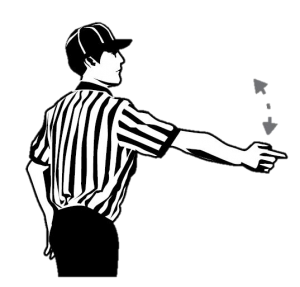 Once the offense has satisfied the initial ten-count, they may not allow the ball to cross the midline unless it happens as the result of a shot or a deflection by the defense. This means that the Lead MUST be sure the Trail knows whether or not the initial count has been satisfied if a ball is rolling toward the midline as he comes up from the Trail spot. If it’s a shot, yell :”shot! If it is a tip, yell “tip!” If neither I am telling my crew to yell “It’s hot!”
Once the offense has satisfied the initial ten-count, they may not allow the ball to cross the midline unless it happens as the result of a shot or a deflection by the defense. This means that the Lead MUST be sure the Trail knows whether or not the initial count has been satisfied if a ball is rolling toward the midline as he comes up from the Trail spot. If it’s a shot, yell :”shot! If it is a tip, yell “tip!” If neither I am telling my crew to yell “It’s hot!”
You may treat this as a “Play on!” but be very careful. Unless the defensive team is DEFINITELY going to get the ball and has a clear path to the goal, kill the play and award the ball. Remember it is not a quick restart as the Trail needs to get into position as the new Lead.
Remember, in order for over an back to be in effect, a count must have ended. So if the ball rolls into the attack box before a ten-count has started (e.g. off a faceoff or a ball rolling across midfield) and then is batted out into the alley or above the defensive restraining line, it may be possessed by the offense and carried or passed over the midline.
The Long Scrum
On occasion, the clearing team will get a loose ball across the midfield line but it is important to remember that the count for advancing into the goal area begins when POSSESSION is gained by the clearing team on the offensive half of their field. As a result you can find yourself in a situation where a loose ball has crossed the midfield line but the ten-second count has not started. This extended loose ball scenario can be go on for a while. Be wary of these long scrums. My advice is to look for the loose ball technical and get the ball up off the ground and into someone’s stick on the restart. Just remember, that if A has not gained the attack area, to begin the play with a 10 count and if B is clearing you have a 20!
Faceoff
Once the face off ends, you have a count. If a player gains possession (carrying, cradling, passing, shooting) in his defensive area, the Trail initiates a 20-second count. If a player gains possession in his offensive side of the field, the Lead initiates a 10-second count. It is a good idea to absolutely sure that a player is in possession before yelling “possession” and starting a count. You do not want to penalize a team for failure to advance if they never had possession to begin with.
In some cases, the Lead may not be able to initiate a count, this most often occurs when the Lead is the Face Off official and is caught up in the play, or is attempting to get to Goal Line Extended and cover his goal. In this case, the Trail should assume the responsibility of conducting the 10 second count.
Once the face off ends with a player gaining possession, a team is either clearing (20) or attempting to gain the box (10). There are no exceptions.
Remember: if you award the ball as a result of a loose ball technical foul before possession is gained on the faceoff or the ball crosses the defensiveness restraining line, we no longer start the play in the offensive end, bit instead wherever the ball is. Therefore, you might have a ten or twenty-second count to begin play. Note that in this situation, until you blow the whistle no player below the defensive restraining line is released.
Who’s Counting!?!
Often a player will secure the ball and either be forced to toss the ball back to his goalie or teammate in his defensive end or after securing the ball in his offensive end, lose the ball. In both cases those counts will continue to run. Do not assume that a player will satisfy the requirements and that you need not initiate a count! Coaches and players are very aware of how long it has been on a clear and will tell their players to “keep him out!” If the play goes on for too long, they will start asking “who is counting!?!” Someone on your crew had better have a timer on OR be in the process of giving the ten count. Be sure to follow the mechanic every time; if you don’t, you are disadvantaging a team by taking away a possession!
- Trail: You ALWAYS have the 4 second and 20 second clearing counts.
- New Lead: as the new Lead ANTICIPATE that you will have to pick up the initial 10 second count. You are on your own until the trail is in position.
If it’s your whistle, It’s your ten-count
If you begin play after a loose ball foul in a teams defensive area, a 20-second count begins. If you begin a play after a foul or a Time Out in a teams offensive area and they HAVE NOT ALREADY SATISFIED the requirement of gaining the attack area or results in a change of possession, the Lead or Trail should begin a new ten-second count begins. It is essential that both officials communicate this to each other before resuming play.
If the play will begin with the ball in the Ally with the Lead, he should begin the count, otherwise the Trail should initiate the count. A great rule of thumb: if its your whistle, its your ten-count. Remember our long scrum/restart situation!
Counts and Change of Possession
This is one of the most difficult plays to officiate is the change of possession while a count is in progress. In a two man game, the Lead is responsible for the 20-second count and the Lead is most often responsible for the ten-second count.
- If there is a change of possession during a clear and the ball is outside the box, the official who sees the change, should initiate a new ten-second count.
- If there is a change of possession during a ten-second count, the official who sees the change should signal to his partner.
“Reset!”
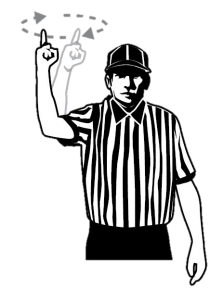 However, on sudden changes in possession, particular when the ball is loose and there is scrum, the official administrating a count OR the official who must now initiate a new count can not see the change in possession. The college mechanics is for officials to raise their arm and twirl their fingers while yelling “Reset!” This lets all officials know a change of possession has occurred old count ends, new count begins. I stress that this is an NCAA mechanic, but if you are working with a veteran official you may come across this mechanic.
However, on sudden changes in possession, particular when the ball is loose and there is scrum, the official administrating a count OR the official who must now initiate a new count can not see the change in possession. The college mechanics is for officials to raise their arm and twirl their fingers while yelling “Reset!” This lets all officials know a change of possession has occurred old count ends, new count begins. I stress that this is an NCAA mechanic, but if you are working with a veteran official you may come across this mechanic.
Mastering Counts
Mastering the rules and mechanics of counts takes time in the rules book, practice and game experience. Study, practice, watch games and game film. Work through situations in your head and talk them out with fellow officials. The time and hard work that you put into truly understanding and properly administering this aspect of the game will elevate you to the next level of your officiating career!
If you have any questions, comments or suggestions, feel free to contact me.
Play On!
Greg Hite
